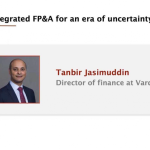Working in FP&A during a crisis is extremely challenging but it is also an opportunity to...
 On October 22nd, 2020 the Global FP&A Trends group hosted another of its insightful webinars, putting in the spotlight the theme of Connected and Collaborative FP&A with its multiple facets – predictive planning, analytics supported by artificial intelligence and machine learning algorithms.
On October 22nd, 2020 the Global FP&A Trends group hosted another of its insightful webinars, putting in the spotlight the theme of Connected and Collaborative FP&A with its multiple facets – predictive planning, analytics supported by artificial intelligence and machine learning algorithms.
In this article, we will walk you through the practical examples and case studies presented by our panellists, the results of the two interactive polling questions and compelling discussions around the journey to a connected planning and a collaborative FP&A function.
Below you will be introduced to our FP&A Board speakers and senior leaders with a broad experience in a wide array of industries who kindly shared some of their own connected and collaborative planning journeys, observations and practical recommendations.

Creating Connected and Collaborative Planning Culture
Integrated or connected FP&A (to not be confused with IBP – Integrated Business Planning) reaches the organisation way beyond the Finance functions.

Integrated FP&A can only be achieved by harmonizing the three key planning processes: (1) strategic planning, (2) business planning and forecasting (FP&A) and (3) operational planning and forecasting both vertically and horizontally into a single/ continuous cross-functional process.
Practical Insights into Connected and Collaborative Planning
According to Elena Kiristova, CFO TUI JV Russia, CIS and CEE, the changes brought to our lives by the COVID-19 pandemic and the “new” normality have changed forever the way we operate, pushing the digital innovation and automation agenda to the forefront of corporate priorities.
Connected and Collaborative Planning brings a number of benefits and changes:
Focus on value-add tasks by moving away from routine operations
Use self-serviced systems that are easy to maintain and user friendly,
Deliver high-quality forecasts, fully aligned with key stakeholders and internal processes
Create consistent information – data flows, driver-based models etc.
Implement warning mechanisms/red flags
Increase focus on business partnering and collaboration with the other business functions
Obtain alignment and full buy-in from key stakeholders
Shorten turnaround times for budgets and forecasts
Increase agility and reaction to changes in assumptions
Balance between detail and granularity
Achieve streamlined and synchronized processes from target setting to forward-looking scenario planning.
FP&A Architecture Importance for Connected Planning
All of the above could not be easily achieved without prioritizing FP&A architecture which helps us build a single source of truth and seamlessly integrate all relevant data in one platform fully underpinning connected planning processes across P&L, balance sheet and cash-flow.
With all of these, we should also expect increased data management requirements.

As Ray Curbelo, Global Head of Finance Solutions, Anaplan commented, in most cases, a “lift and shift” approach can hinder the organization from unlocking the full potential of connected, collaborative planning thus rethinking data architecture is key to enable the new processes, new ways of working and foster collaboration.
Following a great introduction to successful connected and collaborative FP&A provided, we conducted a quick poll to understand how responsive organisations are today in terms of making fast decision and actioning on those decisions based on real-time results.
The poll revealed that only 13% of the respondents are already in a position to achieve this whilst the overwhelming majority (81%) still find it difficult to make and implement quick decisions, being limited by the time required to analyse multiple data sources.

The conclusions of the poll were consistent with the state of facts observed in organisations across the world, data quality being one of the main limitations faced in the journey towards integrated FP&A.
Janssen (EMEA) Practical Experience on Connected and Collaborative Planning
After the discussion on how to create a connected and collaborative planning culture and what to expect this to bring, Stéphanie Didier, Senior Director, Finance and Treasury, Janssen EMEA, shared her experience using connected and collaborative planning.
The below charts based on 2020 FP&A Trends Survey send a very strong message about the gap in FP&A teams resource utilisation vs. the aspirational state where the majority of the time is spent on highly value-adding activities (generating insights or actively driving actions and decisions deployment).

The most time-consuming activities were data collection (14%) and data validation (31%), both of them at the lower end of the value spectrum.
In Janssen EMEA the journey started a couple of years ago. They spend +52 weeks on planning and forecasting and their sales forecasts had an accuracy of 92% which was unsatisfactory when compared to the amount of effort and resources involved in the process.
To achieve the transition to connected planning and predictive forecasting, Janssen EMEA actioned on the following:
Allocated dedicated resources and hired one data scientist
Focused on customizing internal driver-based models leveraging other regions’ existing models and validating them against available historical financial information
Continuous improvements in systems collaboration as a complex IT architecture and systems not talking to each other resulted in a significant amount of time spent on data reconciliations
The target output was to deliver monthly forecasts for the next 18 months, at both country and brand level.
The results proved that the efforts were well justified as the forecasts generated using machine learning algorithms were 4 times out of 6 more accurate than the human forecasts.

The amount of time freed-up overall (estimated around 10 – 20%) was reinvested in value-adding activities such as business partnering and key stakeholders’ engagement, scenario planning.
Based on Stéphanie Didiers’ experience, the key areas that could influence a successful connected planning deployment are:
Change management is critical – whether we are talking about business partners across the organisation or in the Finance function
Develop and upskill FP&A team capabilities as technical language and models need to be translated to both Finance and non-Finance users. Bridge the gap across the business.
Continuously test, learn, adapt and expand to new countries/ products etc. – “Think globally, act locally”
The second Digital FP&A Circle poll surveyed the use of predictive and prescriptive analytics in decision making and revealed that an encouraging 38% of the FP&A Circle members already use these.

Top 5 Success Factors to Achieve Greater Collaborative Planning
Ray Curbelo, Global Head of Finance Solutions, Anaplan, shared some of his experience as an FP&A practitioner and explained how the human and cultural aspects can contribute to enhancing collaborative planning.
The time lag between when a plan/forecast is prepared and the moment it is presented to management (sometimes ranging up to 2.5 months) translates in missed insights.
There are a few key dimensions contributing to how we experience the transition from traditional FP&A to integrated planning:
Increasing abundance of data (customer, business, market) is an opportunity to leverage connectivity and partnerships. Most times we only leverage 10 – 20% of the available data across the organisation in the planning process.
Take an iterative approach – scenario modelling and identifying risks and opportunities is more critical to the business than achieving static perfection. In traditional planning 70 – 90% of the time is spent gathering, cleansing and reconciling data.
Building cross-functional partnerships and gaining visibility to generate insights and drive greater action. In traditional planning siloed work is common and breadth gained by engaging the right business partners with the right expertise to input in the planning process is traded-off against depth.
The opportunity lies in seeing technology as an enabler and using intelligent forecasting to help move away from multiple, dispersed Excel data models and different databases used in planning to rethink the value FP&A drives and shifting focus from data manipulation to a more effective and efficient process having a collaborative culture at the centre.
In summary, the 5 key success factors in achieving collaborative planning are:
Culture – think progress over perfection
Connectivity – build a broader perspective integrating data, models, systems
Transparency on data, systems as the basis for collaboration
Partnering – engaging with the business throughout the entire planning process and applying outcomes towards business actions
Readiness – leverage the capabilities of connected planning (scenario modelling, intelligent forecasting, trade-offs etc.)

Conclusions and Recommendations
Whilst integrated planning is an important tool for modern organisations, we see that they are at different stages in their journey towards achieving this. A significant part of them are still limited by reliance on traditional processes and disparate data sources. Overall it is encouraging to see that the use of predictive and prescriptive analytics in decision making is increasing.
The key take-aways are start small, invest in building a solid IT systems architecture and be aware of increasing data management requirements. In return, expect more efficient and streamlined planning processes, quicker turnaround times to deliver budgets/ forecasts, improved forecasting accuracy, better decision support and effective business partnering etc.
Our Sponsors
We are very grateful to our global sponsor and partner Anaplan for their great support.
Subscribe to
FP&A Trends Digest

We will regularly update you on the latest trends and developments in FP&A. Take the opportunity to have articles written by finance thought leaders delivered directly to your inbox; watch compelling webinars; connect with like-minded professionals; and become a part of our global community.





